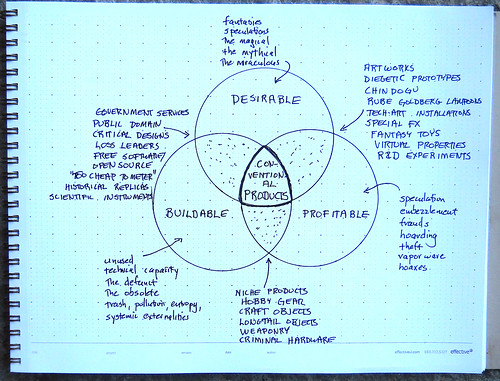This is maybe even less than a short note to point to a little more conversation that @bruces and others are having regarding the Hubberly Venn Diagram I mentioned a few blog posts ago. @AnneGalloway took some fast-furious notes of Bruce discussing it an event: http://www.designculturelab.org/2011/12/09/critically-making-the-internet-of-things-session-i/. Here’s what she says:
* pretty much impossible to take notes but…
“All the gloss of wonder gets scraped off” when the dreams of science fiction become real and commercialised. But also, why is the design in science fiction so bad?
Theory Object for Anticonventional Products
Design fiction instead. See Postscapes’ Best Design Fiction 2011. (Ed. See Note Below)
But what about real products? What science fiction can’t do.
RFID + Superglue + Object ≠ IoT
“It’s easy to be bewitched by the apparent beauty and logic of this. But the map is not the territory.”
Design fiction is a form of design, not fiction.
I’m glad that Bruce mentions this idea that “design fiction is a form of design, not fiction.” As I see it and what hope I have for it as an approach to doing and making is that it isn’t fictional or meant to be disputed because it is “less real” than “real design”. That would be terrible — but that’s entirely up to designers who deploy it as a way of working. If it materializes things that others see as imminently real, tangible — things that cause action, then the question as to its “real-ness” and its factual/actual-ness won’t be disputed. So — make things.
There it is. Glad to see more discussions happening around this. We’ll back-fill it with meaning and utility and make it actionable through making-of-things. I think the Ear Freshener may be the Laboratory’s first test.
Note about Postscapes Best Design Fiction 2011 — Our opinion is that it is fab to have a bit of an awards category for things. It draws attention to the activity and all that. We’re not terribly into awards here — in fact, we cleared out the 7th Floor where we had our Division of Awards and Wall of Gallantry to make space for another solder reflow machine.
But, in any case — there was our Trust Clock listed as an entrant — you can vote for it if you like. It belongs in a different category though because that clock was *made and *works. It still sits in the studio, ticking away the time, ready for someone to get up the gumption and nerve to actually live with. I think there are some great and well-tested bits of design in the form of video prototypes, and they’re fun to look at and ponder.
And then — I think the building-of-the-thing is important and shouldn’t be underemphasized, but not to get puffy about. If there are going to be awards, then perhaps it makes sense to divvy things up a bit and indicate the idiom of design fiction that the design works within? Just a thought. But, that’s to say that the building of that clock forced considerations and questions that I don’t think would’ve occurred had one not had to write firmware and solder and all that. We could’ve stopped at that video, but we had more questions that came directly from writing software and discovering interaction rituals based on making activities — where buttons go, how the alarm fob is given and to whom..real material things that wouldn’t come out in a video. Those questions led to other considerations that really made for actionable design — that can *then be delivered in a tangible way to teams who make products that are closer to the center point of the Hubberly Venn Diagram. You see what I mean? There are things that happen when you make design fiction objects that turn on, can break, have byte code uploaded to them. These are things that make the design thorough — which obtains because of the pain of making the thing *work in a different way from animating it working.
Why do I blog this? To capture more discussions and thinking about the goals of design in a broader sense.
Continue reading Short Note — The Product Design Venn Diagram: Updates
